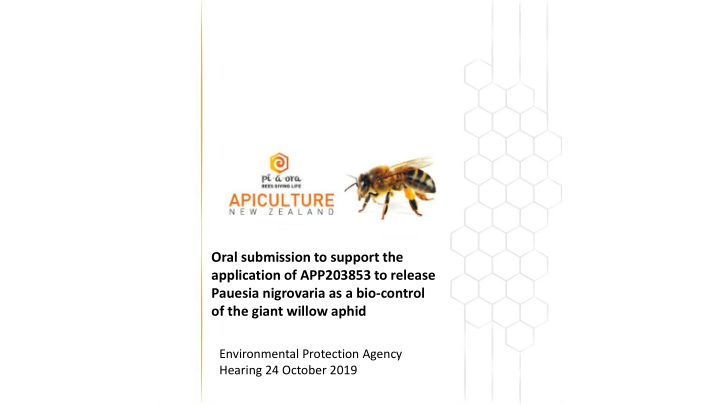



Oral submission to support the application of APP203853 to release Pauesia nigrovaria as a bio-control of the giant willow aphid Environmental Protection Agency Hearing 24 October 2019
Will illow is is a key species that provides polle llen and nectar for beehiv ives in in sprin ing • Difficult to under-estimate the value of willow for spring forage. • Continuous supply of forage needed. • Hives need to be at pollination strength for pip & stone fruit, avocados, apples, kiwifruit and other crops. • 7000 sq. cm of brood – 4 full frames of brood • 12 frames bees • Stores of pollen and nectar • Young queen and AFB free.
Supplementary ry feeding of f hives • Supplementary only • Potential for artificial or cane sugars to show up in honey. C4 test > rejection in international markets. • There is more to natural pollen than found in an artificial supplement. Paper - Honey constituents up-regulate detoxification and immunity genes in the western honey bee Apis mellifera - p-coumaric acid Wenfu Mao, Mary A. Schuler, and May R. Berenbaum, Departments of a Entomology and bCell and Developmental Biology, University of Illinois at Urbana – Champaign, Urbana, IL 61801 Contributed by May R. Berenbaum, March 21, 2013 (sent for review September 8, 2012)
The value of f poll llination to New Zealand • Historic value of apiculture at $5 billion annually • Kiwifruit $1.85 billion 2017/18 $4.5 billion by 2025. (Zespri projections.) • Add in horticulture, seed crops and pasture legumes = figure much higher. • Increasing demand for hives • Recognized threat to willow health and bee health in 2013.
Wil illow honey dew Sugar Composition ex T. E. Mittler 1958 • Ex stylet sap (~25 mm 3 /day) - sucrose only <<aphid>> • In honeydew - sucrose (G-F) - glucose (G) - fructose (F) - melezitose (G-F-G)
Sugars in Willow Honeydew Honey cf Manuka unit WH1 WH2 WH3 WH4 Manuka Fructose g/100g 29.25 28.80 32.62 30.28 39.8 Glucose g/100g 16.69 16.43 21.93 20.18 29.9 Sucrose g/100g <0.5 <0.5 <0.5 <0.5 <0.5 Melezitose g/100g 17.88 17.00 11.47 15.31 0.1 F+G+M g/100g 63.82 62.23 66.02 65.77 69.8 Ex Terry Braggins, Analytica
Melezitose sugar is indigestible by bees • Over 30% melezitose sugar in willow honey dew. • Melezitose sugar at 17%> in a honey changes it from liquid to a solid. Happens when bees are ripening the honey in the frames. • False weight in stores for a wintering hive. • Bees use energy to remove it. • Difficult if not impossible to extract with honey processing.
White crystals also seen on monitoring boards and base boards
The Wasp problem exacerbated by GWA around 12.1 .1% annual lo loss
Threat to international trade in NZ honey • The melezitose in willow honey dew honey if found through testing of export shipments of New Zealand mono-floral honey can lead to the re-labelling or rejection of export shipments. • Willow honey dew leads to the need for more testing and hence cost before packing for markets. • International markets are very aware of any potential contaminants in or adulteration of natural honey.
Recommend
More recommend